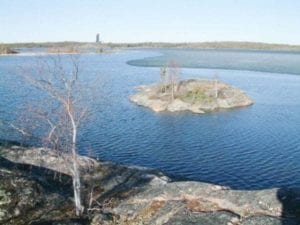Decision comes after public health advisory relied on decades-old arsenic data

The Department of Environment and Natural Resources has begun
performing its own testing for arsenic at Kam Lake. More recent data of arsenic concentration shows around 200 parts per billion, still far from safe drinking water levels.
The Department of Environment and Natural Resources has begun new water quality testing to measure arsenic levels at Kam Lake this week.
"We felt it was something that would be good to undertake in terms of taking some additional samples," said Robert Jenkins, director of water resources at the department.
According to Jenkins, the department already has the last three years' worth of water quality data on Kam Lake from Miramar Northern Mining Ltd., the company in charge of remediating Con Mine.
Miramar has been reporting its Kam Lake monitoring results publicly to the Mackenzie Valley Land and Water Board since 2012, according to department spokesperson Judy McLinton.
While Miramar tests Kam Lake monthly during open-water season, Jenkins said his department is testing ice water and will take additional samples from seven different places on the lake.
"It sort of compliments some of that work," he said. "It samples from different areas."
The department doesn't yet have concrete plans to test arsenic in other lakes around Yellowknife but officials are compiling data on water quality in a number of lakes around the city from existing resources, including a 2014 University of Ottawa study, McLinton said.
The department's decision to do its own water quality testing comes after the territory's chief public health officer issued a health advisory that relied on a 1989 study to warn residents of dangerously high arsenic levels in Kam Lake. The study put the lake's arsenic concentration at 50 times above the federal guideline for safe drinking water. At the time, Dr. Andre Corriveau said it was the best data available.
Kam Lake MLA Kieron Testart responded by stressing the need for fresh testing of arsenic levels in lakes around Yellowknife and for that information to be made easily accessible to residents.
Arsenic levels fall
But Miramar already had fresh data that the department of environment was aware of when the chief public health officer released the advisory containing stale information.
A recent Miramar report shows Kam Lake's arsenic levels were 213 parts per billion on Oct. 21, 2016 – much less than the 500 parts per billion shown in the 1989 study. That's still far from the acceptable drinking water standard of less than 10 parts per billion.
"I wasn't aware that they were doing testing every year," Corriveau said.
Jenkins said the department of environment has since informed Corriveau's office and the health department of the more recent data, which Corriveau plans to use to update the public health advisory.
"We're having discussions with them to ensure that the communication lines are clear and that the transfer of information is efficient," Jenkins said.
While Testart said he is pleased the government is performing new testing, he said the interdepartmental confusion is a problem.
"It's the right hand not knowing what the left is doing," he said. "When it comes to human health and safety, there should be no barriers."
Informing his constituents about Kam Lake is the "bottom line" for Testart, but he said he will continue to raise the fact that other lakes around the city could be tested again during legislative assembly sittings.
"It's good to have these discussions and push the government a bit more," Testart said. "This is something the public cares about, as we've seen with Kam Lake, and it's no longer acceptable for our government to think people just assume the lakes are unsafe."
When Yellowknifer asked the environment department why it didn't make the public aware of the more recent arsenic data several years ago when it had it, Jenkins said that's because the data is already available through the Mackenzie Valley Land and Water Board registry.
He suggested showcasing that data for residents on the department's website would be repetitive. Any resident facing challenges finding arsenic information could have requested help from the department or the water board to find it, he said, adding issues with being able to access data easily should be left to the water board.
"This is information that's a legal requirement of their (Miramar's) water licence that's administered by the board, and they have a public registry," Jenkins said. "For us to duplicate that would be a duplication of effort."